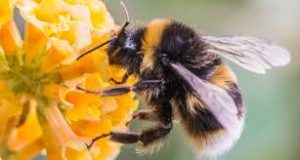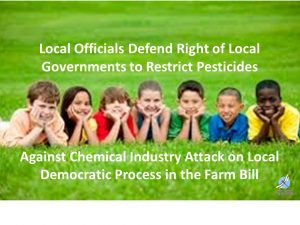04
Oct
Glyphosate Linked to Bee Deaths in University of Texas Study
 (Beyond Pesticides, October 4, 2018) According to new research from the University of Texas at Austin, glyphosate, the worldâs most widely used agrichemical weed killer, may also be killing bees by impairing their gut microbiota, and subsequently, their immune systems. The study, published in the journal Proceedings of the National Academy of Sciences, titled Glyphosate perturbs the gut microbiota of honey bees, notes these findings as evidence glyphosate could very well be contributing to the sharp decline of pollinators seen throughout the world over the past decade.
(Beyond Pesticides, October 4, 2018) According to new research from the University of Texas at Austin, glyphosate, the worldâs most widely used agrichemical weed killer, may also be killing bees by impairing their gut microbiota, and subsequently, their immune systems. The study, published in the journal Proceedings of the National Academy of Sciences, titled Glyphosate perturbs the gut microbiota of honey bees, notes these findings as evidence glyphosate could very well be contributing to the sharp decline of pollinators seen throughout the world over the past decade.
Researchers began with a single hive and collected several hundred worker bees. One group of bees was fed a sterile sugar syrup, while others were exposed to levels of glyphosate equal to what is found in conventional crop fields, lawns and highway medians. To aid tracking and recapture, bees were marked with colored dots based on their grouping. Researchers sampled 15 individuals from each group of worker bees right before and three days after reintroduction back to the hive. At both times, DNA from the insectsâ guts was extracted to observe whether glyphosate had significantly altered microbial diversity within their organ system.
Results found relatively minimal impacts to bees tested prior to their reintroduction to the hive. However, bees tested three days after returning to their hive revealed significant changes in their gut make-up, trending towards lower levels of important beneficial gut bacteria when compared to unexposed bees. Of eight key species of beneficial bacteria in the exposed honey beesâ microbiome, four were found to be less abundant. In fact, the bacteria species most directly affected, Snodgrassella alvi, is crucial for aiding the beesâ ability to both process food and defend against harmful pathogens.
Erick Motta, the graduate student who led the research, said: âWe need better guidelines for glyphosate use, especially regarding bee exposure,â noting that EPA regulation guidelines âassume bees are not harmed by the herbicide,â though this study, like others, shows such an assumption of safety to be wildly ill-informed.
Indeed, such diverse bacteria are what keep immune systems resilient against illness and other types of stresses. Regardless of their role in maintaining a functioning immune system, the chemical industry has trolled homeowners to both distrust and work swiftly to exterminate all bacteria with a panoply of toxic products.
As a result of glyphosate exposure, honey bees with weakened gut microbiomes were later more likely to die after coming in contact with the widespread pathogen, Serratia marcescens. Noting the pathogenâs detrimental effect on honey bees, about half of unexposed honey bees with healthy immune systems were able stave off infection and stay alive eight days after contracting the pathogen. Comparatively, only one tenth of the bees exposed to glyphosate were still alive eight days after contracting the pathogen. Without a resilient immune system propped up by a healthy microbiome, the study finds further evidence that living organisms find it increasingly difficult to maintain health amidst our toxic-plagued urban environments and conventional agriculture.
Such a negative impact on gut microbiome is devastating for pollinators already assailed by immune-system-compromising chemicals, scarcity of diverse forage, and environmental pressures on habitat. Glyphosate, for all who are not familiar, is one of the worldâs most widely and indiscriminately sprayed pesticides. Its annual use in the U.S. has soared from 40 million pounds in the mid-1990s to around 300 million pounds used annually today. And unsurprisingly, resistance to the pesticide continues to increase in target species due such excessive use.
This isnât the first study to find adverse impacts from pollinator exposure to glyphosate. In 2015, a study linked glyphosate exposure to impaired learning in honey bees, with evidence that field realistic doses of the chemical cause delays in the return of foraging honey bees to the hive.
And the effect of glyphosate on gut diversity is not limited to pollinators, according to recent research. Beyond Pesticides summer 2017 Pesticides and You article, Monsantoâs Roundup (Glyphosate) Exposed explores how this herbicide may also be weakening human immune systems by disrupting our gut microbiome.
As co-author of the study, Professor Nancy Moran, Ph.D., stated to Sustainable Pulse: âStudies in humans, bees and other animals have shown that the gut microbiome is a stable community that resists infection by opportunistic invaders. So if you disrupt the normal, stable community, you are more susceptible to this invasion of pathogens.â
Important work on the human gut microbiome has be getting more public attention. The summer 2017 issue of Beyond Pesticidesâ journal, Pesticides and You, contains an article on the importance of soil microbiota and human gut microbome. The lead article, Sustaining Life: From Soil Microbiota to Gut Microbiome by professor of geomorphology (University of Washington) and author David Montgomery, PhD, contains excerpts from Dr. Montgomeryâs talk to Beyond Pesticidesâ 35th National Pesticide Forum, documenting the importance of soil microbiota to healthy soil, resilient plants, and sustainability. (See Dr. Montgomery’s full talk.) His piece explains the essentiality of bacteria in the human gut to a healthy life, with profound implications for both agriculture and medicine. Dr. Montgomery points to a âbonafide scientific revolutionâ in recognizing the failure to nurture the ecosystem in nature and the human body and the associated adverse health effects resulting from pesticide use â21st century diseases, including asthma, autism, bacterial vaginosis, cardiovascular disease, cancer, Crohnâs disease, depression, inflammatory bowel disease, leaky gut syndrome, multiple sclerosis, obesity, Type 1 and 2 diabetes, and Parkinsonâs. For more information, see Daily News.
Additional information on glyphosate can be found on Beyond Pesticidesâ Pesticide Gateway entry for the chemical. For more resources on how pesticides impact pollinators, and information about what you can do visit the What the Science Shows page, and watch Beyond Pesticidesâ new video Seeds that Poison.
All unattributed positions and opinions in this piece are those of Beyond Pesticides.
Source: Sustainable Pulse
All unattributed positions and opinions in this piece are those of Beyond Pesticides.









 (Beyond Pesticides, October 3, 2018) REMINDER: The Fall 2018 NOSB public comments are due by Thursday, October 4, 2018. Your comments and participation are critical to the integrity of the organic label. Written comments may be submitted throughÂ
(Beyond Pesticides, October 3, 2018) REMINDER: The Fall 2018 NOSB public comments are due by Thursday, October 4, 2018. Your comments and participation are critical to the integrity of the organic label. Written comments may be submitted through  (Beyond Pesticides, October 2, 2018) The U.S. Environmental Protection Agency (EPA) is asking an appeals court to rehear a case that previously ruled EPA must immediately ban the brain-harming pesticide
(Beyond Pesticides, October 2, 2018) The U.S. Environmental Protection Agency (EPA) is asking an appeals court to rehear a case that previously ruled EPA must immediately ban the brain-harming pesticide  (Beyond Pesticides, October 1, 2018)Â Last year, pesticide manufacturers tried to undo local pesticide ordinances in a large state-by-state lobbying effort. That failed. Now they are trying to get Congress to undo these local rules in one fell swoop through an amendment in the Farm Bill.
(Beyond Pesticides, October 1, 2018) Last year, pesticide manufacturers tried to undo local pesticide ordinances in a large state-by-state lobbying effort. That failed. Now they are trying to get Congress to undo these local rules in one fell swoop through an amendment in the Farm Bill. (Beyond Pesticides, September 28, 2018) Despite French President, Emmanuel Macronâs pledge to see glyphosate banned in his country, French ministers of parliament (MPs) have once again refused to enter the banning of glyphosate into legislation. Glyphosateâs use in Europe has come under scrutiny and heated debate. But despite evidence of harms, and interference by Monsanto, the European Union (EU) extended its license last year. However, France has pledged to ban the chemical within a few years.
(Beyond Pesticides, September 28, 2018) Despite French President, Emmanuel Macronâs pledge to see glyphosate banned in his country, French ministers of parliament (MPs) have once again refused to enter the banning of glyphosate into legislation. Glyphosateâs use in Europe has come under scrutiny and heated debate. But despite evidence of harms, and interference by Monsanto, the European Union (EU) extended its license last year. However, France has pledged to ban the chemical within a few years. (Beyond Pesticides, September 27, 2018) The U.S. Environmental Protection Agency’s (EPA) Office of the Inspector General (OIG) released aÂ
(Beyond Pesticides, September 27, 2018) The U.S. Environmental Protection Agency’s (EPA) Office of the Inspector General (OIG) released a 
 (Beyond Pesticides, September 25, 2018) Last week the pioneering yogurt maker
(Beyond Pesticides, September 25, 2018) Last week the pioneering yogurt maker  Beyond Pesticides, September 24, 2018)Â In a move that critics fear may be a pretext for gutting federal agricultural research, U.S. Secretary of Agriculture Sonny Perdue has proposed overhauling two federal offices overseeing food and agriculture research and moving them out of the Washington, DC area. A plan announced in August to relocate one of the U.S. Department of Agricultureâs (USDA) top research office â the Economic Research Service â into the Office of the Secretary, a political branch of the U.S. Department of Agriculture, is raising alarm from scientists. Concerned researchers see the move as a way to cut funding to important projects on climate change and nutrition, among others, consistent with
Beyond Pesticides, September 24, 2018) In a move that critics fear may be a pretext for gutting federal agricultural research, U.S. Secretary of Agriculture Sonny Perdue has proposed overhauling two federal offices overseeing food and agriculture research and moving them out of the Washington, DC area. A plan announced in August to relocate one of the U.S. Department of Agricultureâs (USDA) top research office â the Economic Research Service â into the Office of the Secretary, a political branch of the U.S. Department of Agriculture, is raising alarm from scientists. Concerned researchers see the move as a way to cut funding to important projects on climate change and nutrition, among others, consistent with  (Beyond Pesticides, September 20, 2018) Babies exposed to higher levels of organochlorine compounds in the womb go on to have worse lung function in childhood, according to new research presented at the European Respiratory Society International Congress. Previous studies have found a link between low lung function in early adulthood and respiratory, cardiovascular, and metabolic issues in later life. Beyond Pesticides has covered in its Daily News studies on a range of adverse effects, including
(Beyond Pesticides, September 20, 2018) Babies exposed to higher levels of organochlorine compounds in the womb go on to have worse lung function in childhood, according to new research presented at the European Respiratory Society International Congress. Previous studies have found a link between low lung function in early adulthood and respiratory, cardiovascular, and metabolic issues in later life. Beyond Pesticides has covered in its Daily News studies on a range of adverse effects, including  (Beyond Pesticides, September 19, 2018) ââDonât get pregnant at George Air Force Baseââ was the
(Beyond Pesticides, September 19, 2018)Â ââDonât get pregnant at George Air Force Baseââ was the  (Beyond Pesticides, September 18, 2018) While climate change campaigners have long warned of increased pest pressure as a result of a warming planet, new research published in Science has begun to envisage the true extent of this expanding crisis for agriculture and crop yields. An Earth warmed by 2 degrees Celsius will see significant increases in insect metabolism and population growth, increasing global food scarcity. The study underlines the need to move towards more sustainable agricultural models that can better handle pests and other stressors brought about by climate change.
(Beyond Pesticides, September 18, 2018) While climate change campaigners have long warned of increased pest pressure as a result of a warming planet, new research published in Science has begun to envisage the true extent of this expanding crisis for agriculture and crop yields. An Earth warmed by 2 degrees Celsius will see significant increases in insect metabolism and population growth, increasing global food scarcity. The study underlines the need to move towards more sustainable agricultural models that can better handle pests and other stressors brought about by climate change. (Beyond Pesticides, September 14, 2018) A lawsuit
(Beyond Pesticides, September 14, 2018) A lawsuit  (Beyond Pesticides, September 12, 2018) The city of Amsterdam, Netherlands is leading global bee recovery efforts by increasing its diversity of wild pollinator species, according to
(Beyond Pesticides, September 12, 2018) The city of Amsterdam, Netherlands is leading global bee recovery efforts by increasing its diversity of wild pollinator species, according to  (Beyond Pesticides, September 11, 2018) A report released this summer by the nonprofit group The Cornucopia Institute helps consumers avoid âfactory farmedâ dairy products in light of disturbing revelations uncovered in a
(Beyond Pesticides, September 11, 2018) A report released this summer by the nonprofit group The Cornucopia Institute helps consumers avoid âfactory farmedâ dairy products in light of disturbing revelations uncovered in a  (Beyond Pesticides, September 10 2019)Â Does your community spray toxic pesticides for mosquitoes? In a well-intentioned but ill-informed attempt to prevent mosquito-borne illness such as West Nile virus, many communities spray insecticides (adulticides) designed to kill flying mosquitoes. If your community is one of these, then your public officials need to know that there is a better, more-effective, way to prevent mosquito breeding.
(Beyond Pesticides, September 10 2019)Â Does your community spray toxic pesticides for mosquitoes? In a well-intentioned but ill-informed attempt to prevent mosquito-borne illness such as West Nile virus, many communities spray insecticides (adulticides) designed to kill flying mosquitoes. If your community is one of these, then your public officials need to know that there is a better, more-effective, way to prevent mosquito breeding.
 (Beyond Pesticides, September 6, 2018) Red swamp crayfish have long been associated with Louisiana and Gulf Coast bayous, but the species has found new homes throughout the world over the last 70 years, and evidence is showing that their introduction may alter ecosystems in ways that increase mosquito populations and human disease risk. Â In late August, researchers at the University of California, Los Angeles and Pepperdine University published new evidence in the
(Beyond Pesticides, September 6, 2018) Red swamp crayfish have long been associated with Louisiana and Gulf Coast bayous, but the species has found new homes throughout the world over the last 70 years, and evidence is showing that their introduction may alter ecosystems in ways that increase mosquito populations and human disease risk. Â In late August, researchers at the University of California, Los Angeles and Pepperdine University published new evidence in the 
 (Beyond Pesticides, September 4, 2018) Close on the heels of the recent
(Beyond Pesticides, September 4, 2018) Close on the heels of the recent 
